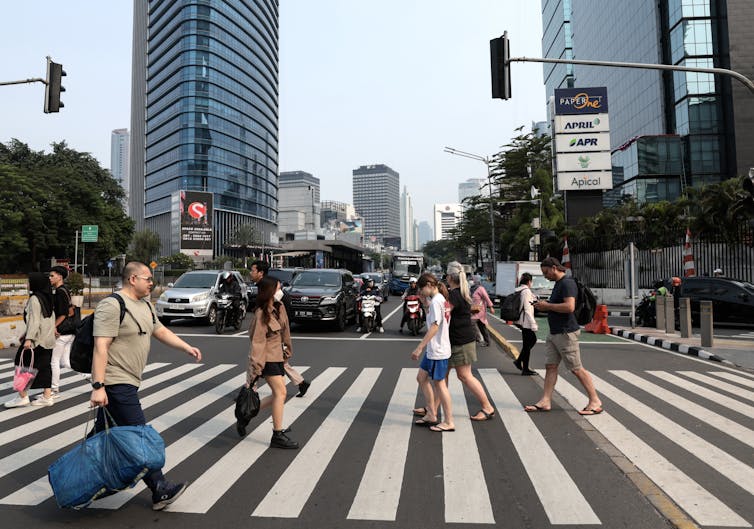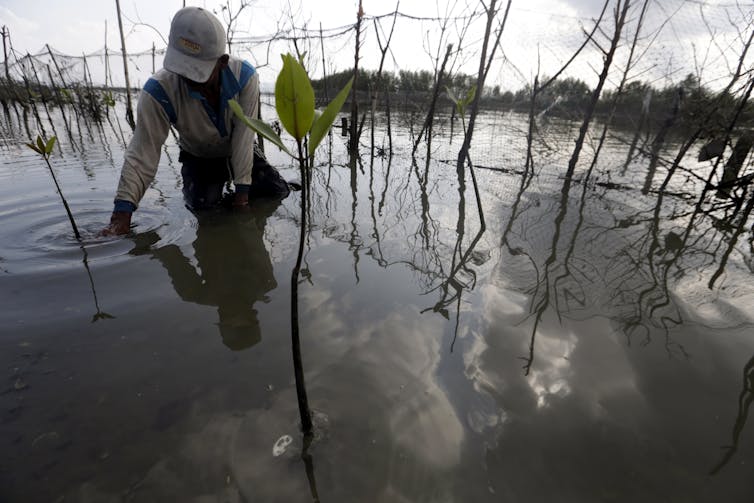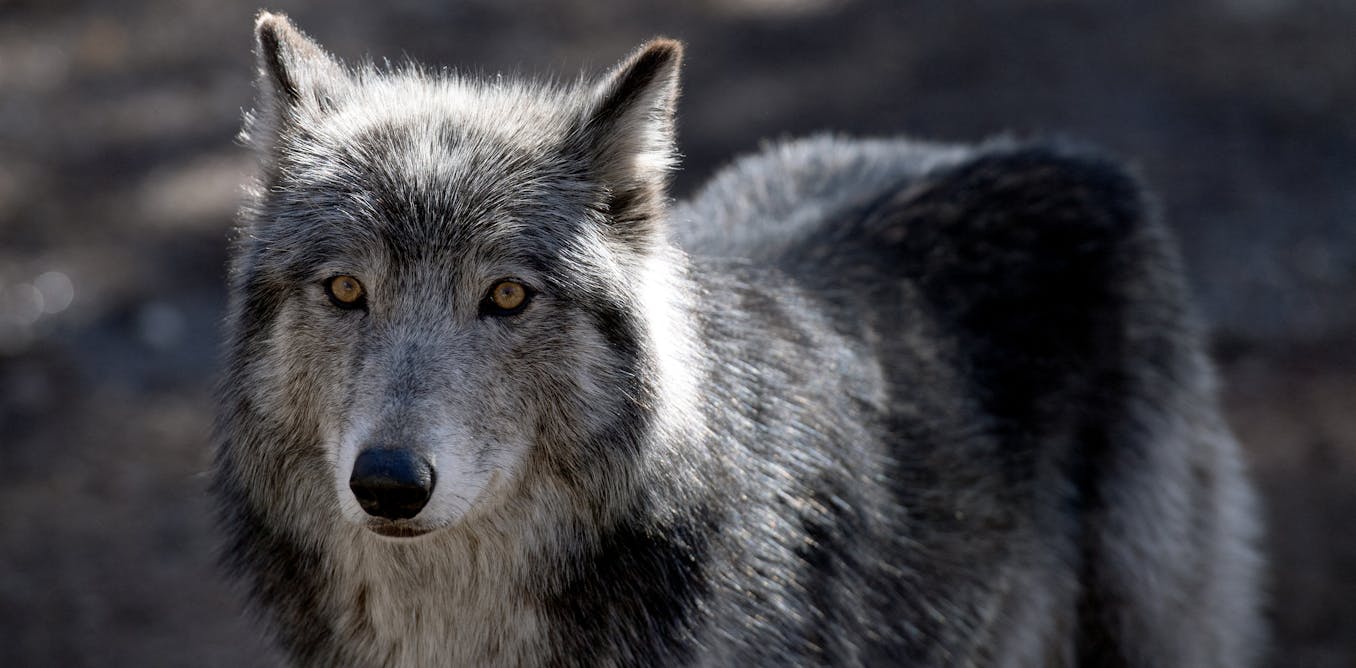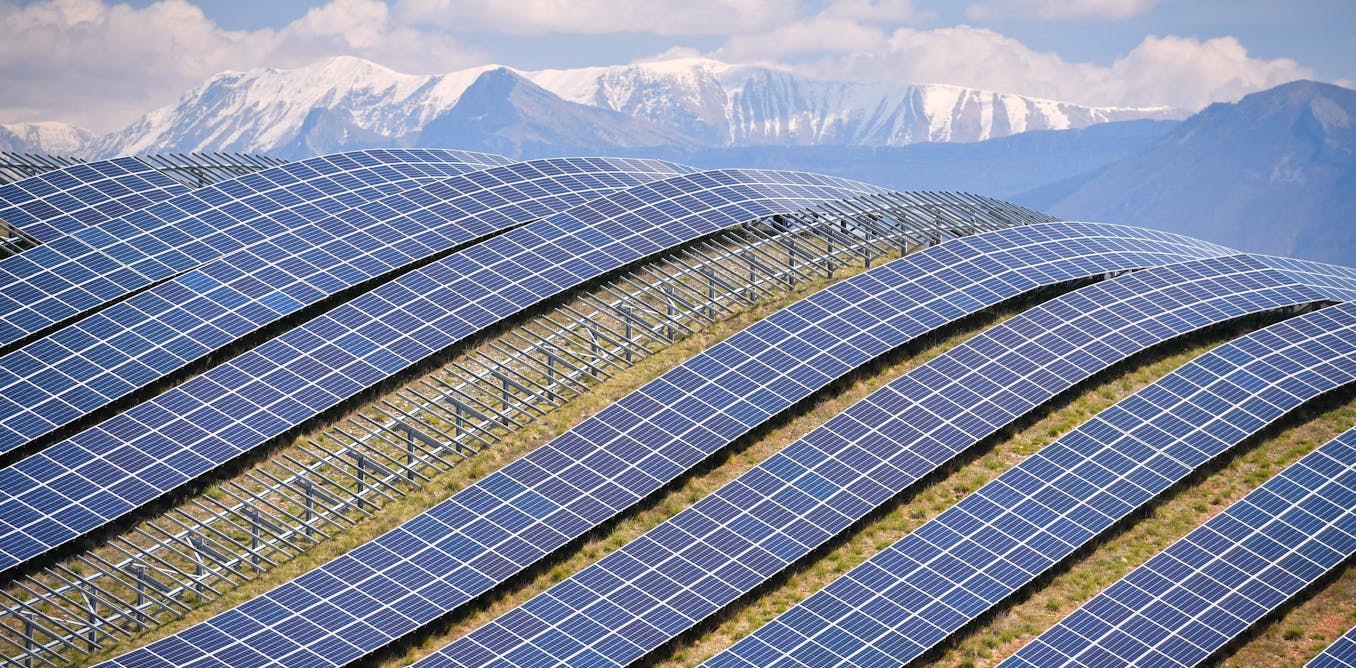Much of the climate conversation in Australia to date has centred on actions to limit global warming, recognising that each increment of warming contributes to worsening climate extremes.
In a recently released book, Living Hot: Surviving and Thriving on a Heating Planet, authors Clive Hamilton and George Wilkenfeld argue while emissions reduction should continue, Australia should refocus its efforts on “adaptation”, or building resilience to the effects of climate change.
Certainly, Australia cannot ignore adaptation. Extreme weather, driven by climate change, repeatedly batters much of the country – and some areas get little reprieve between natural disasters.
But Australia’s emissions-reduction efforts must continue in haste, at large scale. Real change is possible. It will require everything, everywhere, all at once.
Jason O’Brien/AAP
Mixed progress
The world is on track to warm by almost 3°C on pre-industrial levels, unless current national pledges to reduce emissions are ramped up.
Climate change is already leading to more intense and frequent extreme weather events in Australia’s global region, the Asia-Pacific.
However, the region’s progress on climate action has been mixed at best. As such, many countries are seeking to adapt to their “new normal”.
Indonesia, for example, is moving its capital city from sinking Jakarta to the new city of Nusantara – partly as a climate adaptation measure.
And in Malaysia, Monash University academics are exploring new ways to educate citizens and adapt buildings in the era of global warming.
Of the world’s high-income nations, Australia is one of the most vulnerable in a warmer world. We must focus on both cutting our emissions, and fundamentally rethinking how we live.

Adi Weda/EPA
Mitigation and adaptation: two sides of a coin
When we prioritise both cutting emissions and adapting to climate change, twin benefits can flow.
Research by our organisation, Climateworks Centre, shows how this applies to conserving ocean ecosystems around Indonesia, the largest archipelago-nation in the world.
Mangroves, with their strong root systems, help protect coastal communities and lands from extreme weather events. They can also provide significant long-term “sinks”, or storage, for carbon.
Protecting these important ocean ecosystems can bolster Indonesia’s climate resilience and avoid more carbon entering the atmosphere. It’s a win-win for both adaptation and mitigation.
Similarly in Australia, the choices we make around land use can help us both mitigate and adapt to climate change. This understanding underpins the world-leading “Land Use Trade-offs” model, originally developed by CSIRO.
Climateworks and Deakin University released a new version of the model in 2023. It maps the best way to use and manage land in Australia to meet climate targets, agricultural demand and biodiversity goals.
For example, well-designed solar arrays can produce clean energy and increase livestock productivity, by sheltering sheep and protecting pasture.

HOTLI SIMANJUNTAK/EPA
Technology is outpacing expectations
Hamilton and Wilkenfeld argue humanity relies on a technology-only approach to climate action at our own peril.
There is truth here. However, technological advances to date cannot be understated. In fact, many renewable technologies have consistently outpaced our expectations – such as affordable solar, batteries, electric vehicles and LED lights.
There is also great potential for technology to lower emissions in Australia’s heavy industry.
In 2022, an initiative co-convened by Climateworks found 70 million tonnes of emissions reduction was possible in just five industrial regions of Australia – representing an 88% reduction – if timely, effective action was taken. This action also sets Australia up to make good on its superpower ambition, as a producer of green steel and hydrogen.
Living Hot highlights the immense increase required in Australia’s renewable energy supply if everything currently powered by fossil fuels is to be powered by clean sources. We agree. Australia’s electricity and grid needs are far bigger than we have planned for to date.
This pressure on the grid can be reduced, however. We could use energy far more efficiently in our homes, businesses and industries.
And in some cases, these changes bring multiple benefits. Well-designed homes are cooler in summer and warmer in winter. They are also cheaper to run, more resilient to climate-driven extremes and use less energy.

Dean Lewins/AAP
Regional cooperation is key
The authors of Living Hot argue nothing Australia does “can appreciably change the climate Australians will live through in 2050 and beyond”.
In isolation, this could well be the case. But Australia can have a significant impact on global efforts to tackle climate change, if it responds to calls from our region to cooperate meaningfully on emissions reduction.
Over the last two decades, emissions in the Southeast Asian region have grown nearly 5% a year as nations in the region rapidly industrialise.
Left unchecked, this emissions-intensive growth risks pushing global warming past thresholds crucial for stabilising Earth’s climate.
Australia and our region can provide many of the minerals and materials needed in the transition to clean energy. To achieve this, Australia should work collaboratively with our Indo-Pacific neighbours, such as helping them acquire the specialised skills needed to decarbonise.
Looking to COP31
Australia is bidding to host the 2026 United Nations climate conference, COP31, in partnership with our Pacific neighbours.
If we succeed, it would provide a once-in-a-generation opportunity to champion the urgency of both ambitious climate mitigation and adaptation in our region.
For the Pacific, climate adaptation is existential. Tuvalu is maintaining its identity, even though its land could disappear in mere decades. But in Southeast Asia, the greater challenge, and economic opportunities, remain in mitigating emissions.

Richard Vogel/AP
Dramatic emissions reduction – enough to slow, and eventually stop global warming – will give nations longer to adapt.
Australia has a lot to lose in the face of climate change, but also a lot to gain. We are one of the sunniest and windiest places on the planet, with a vast landmass and rich reserves of critical minerals needed in the energy transition.
A more certain, safer future for all is within our grasp. It requires both going as hard as possible on reducing emissions, and adapting to the changes ahead.

The post “Australia’s survival in a warmer world will be a mammoth multi-tasking effort” by Luke Brown, Head of Policy and Engagement, Climateworks Centre was published on 08/09/2024 by theconversation.com






































Leave a Reply